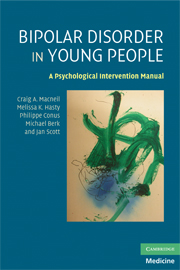Book contents
- Frontmatter
- Contents
- Preface
- Acknowledgements
- Introduction
- 1 Bipolar disorder
- 2 Assessment and engagement
- 3 Insight, adaptation, and functional recovery
- 4 Medication adherence
- 5 Cognitive behavioral therapy interventions
- 6 Social rhythm regulation
- 7 Relationship issues and family work
- 8 Alcohol, substance abuse, and other comorbid disorders
- 9 Identifying early warning signs, preventing relapse, and termination of therapy
- Appendices
- References
- Index
5 - Cognitive behavioral therapy interventions
Published online by Cambridge University Press: 06 July 2010
- Frontmatter
- Contents
- Preface
- Acknowledgements
- Introduction
- 1 Bipolar disorder
- 2 Assessment and engagement
- 3 Insight, adaptation, and functional recovery
- 4 Medication adherence
- 5 Cognitive behavioral therapy interventions
- 6 Social rhythm regulation
- 7 Relationship issues and family work
- 8 Alcohol, substance abuse, and other comorbid disorders
- 9 Identifying early warning signs, preventing relapse, and termination of therapy
- Appendices
- References
- Index
Summary
What we are today comes from our thoughts of yesterday, and our present thoughts build our life of tomorrow: Our life is the creation of our mind.
Buddha, in Haidt (2006, p. 23)Introduction
As described in Chapter 1, a significant evidence base is emerging to support the application of CBT and other structured psychological interventions in the treatment of bipolar disorder. In a number of randomized controlled trials, CBT has been shown to decrease the duration of acute depressive episodes, extend the time between relapses, reduce hospitalization rates, and improve medication adherence and psychosocial functioning (for reviews see Huxley et al., 2000; Scott & Colom, 2005; Beynon et al., 2008). In addition, targeting prodromal cognitive changes, such as referential beliefs, has been found to increase the likelihood of successful outcomes in people with bipolar disorder (see review by Goldberg et al., 2005).
The focus of this chapter will be on the clinical application of selected cognitive behavioral techniques that we have noted to be particularly useful when working with young people with bipolar disorder.
CBT for young people with bipolar disorder: a phase-specific intervention
People require different elements of a cognitive behavioral intervention depending on their phase of the disorder. Specifically, in the acute phase, the emphasis tends to be on managing behavioral issues and risk reduction, including reducing stimuli if the person is manic or hypomanic, or increasing stimuli if depressed.
- Type
- Chapter
- Information
- Bipolar Disorder in Young PeopleA Psychological Intervention Manual, pp. 65 - 97Publisher: Cambridge University PressPrint publication year: 2009

